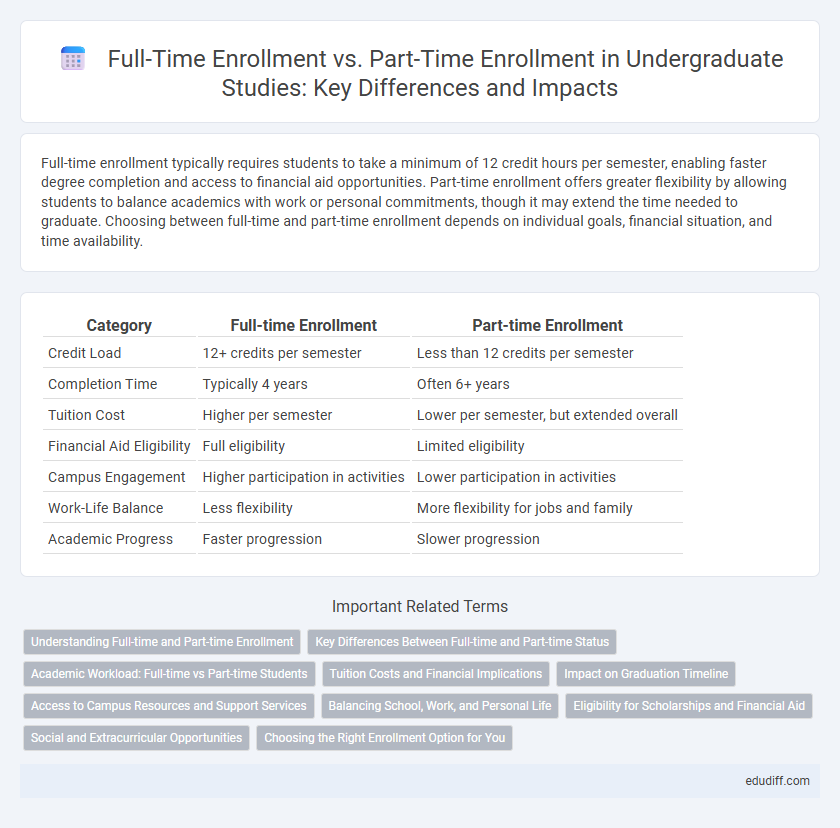Full-time enrollment typically requires students to take a minimum of 12 credit hours per semester, enabling faster degree completion and access to financial aid opportunities. Part-time enrollment offers greater flexibility by allowing students to balance academics with work or personal commitments, though it may extend the time needed to graduate. Choosing between full-time and part-time enrollment depends on individual goals, financial situation, and time availability.
Table of Comparison
| Category | Full-time Enrollment | Part-time Enrollment |
|---|---|---|
| Credit Load | 12+ credits per semester | Less than 12 credits per semester |
| Completion Time | Typically 4 years | Often 6+ years |
| Tuition Cost | Higher per semester | Lower per semester, but extended overall |
| Financial Aid Eligibility | Full eligibility | Limited eligibility |
| Campus Engagement | Higher participation in activities | Lower participation in activities |
| Work-Life Balance | Less flexibility | More flexibility for jobs and family |
| Academic Progress | Faster progression | Slower progression |
Understanding Full-time and Part-time Enrollment
Full-time enrollment typically requires students to take 12 to 18 credit hours per semester, enabling faster degree completion and eligibility for financial aid benefits. Part-time enrollment allows for fewer credits per semester, offering flexibility for students balancing work, family, or other commitments, but extending the overall duration of study. Understanding the distinctions between full-time and part-time enrollment helps students make informed decisions aligned with their academic and personal goals.
Key Differences Between Full-time and Part-time Status
Full-time enrollment typically requires students to take 12 to 18 credit hours per semester, allowing for faster degree completion and eligibility for full financial aid benefits. Part-time enrollment involves fewer than 12 credit hours, offering greater flexibility for working students but often extending the time needed to graduate. Key differences include tuition rates, course load intensity, and access to campus resources such as advising and extracurricular activities.
Academic Workload: Full-time vs Part-time Students
Full-time students typically enroll in 12 to 18 credit hours per semester, resulting in a heavier academic workload that demands consistent daily study and assignment completion. Part-time students usually take fewer than 12 credit hours, allowing for more flexibility but often extending the time needed to graduate. The difference in enrollment status directly impacts course intensity, time management strategies, and academic progress in undergraduate programs.
Tuition Costs and Financial Implications
Full-time enrollment often results in higher upfront tuition costs but may provide access to greater financial aid opportunities, including scholarships and grants tailored for full-time students. Part-time enrollment typically reduces immediate tuition expenses per semester but can extend the duration of degree completion, potentially increasing overall costs related to fees and living expenses. Students must weigh the financial benefits of full-time aid eligibility against the flexibility and lower short-term costs of part-time study.
Impact on Graduation Timeline
Full-time enrollment typically accelerates the graduation timeline by allowing students to complete a higher credit load each semester, often finishing a bachelor's degree in four years. Part-time enrollment extends the duration of study, as students take fewer courses per term, potentially prolonging graduation by several years. Choosing between full-time and part-time enrollment impacts academic planning, financial aid eligibility, and long-term career development.
Access to Campus Resources and Support Services
Full-time undergraduates typically have greater access to campus resources and support services such as academic advising, career counseling, and student organizations compared to part-time students. Many universities prioritize resource availability and event scheduling during standard weekday hours, which aligns more closely with full-time students' schedules. Part-time students may face limitations in accessing these services due to reduced campus presence and less flexible hours.
Balancing School, Work, and Personal Life
Full-time enrollment demands a significant time commitment, often requiring students to balance a rigorous class schedule with work and personal responsibilities, which can impact stress levels and academic performance. Part-time enrollment offers greater flexibility by allowing students to manage coursework alongside employment and family obligations, supporting better work-life-school balance. Research indicates that part-time students may experience less burnout but may take longer to graduate compared to full-time peers.
Eligibility for Scholarships and Financial Aid
Full-time enrollment typically qualifies students for a wider range of scholarships and financial aid packages, as many institutions and funding bodies require a minimum credit load to maintain eligibility. Part-time students often face limited access to grants and merit-based scholarships, with need-based aid sometimes available but usually reduced. Understanding each institution's specific policies on enrollment status is crucial for maximizing financial support opportunities.
Social and Extracurricular Opportunities
Full-time undergraduate students typically have greater access to social and extracurricular opportunities, as their schedules allow participation in campus clubs, organizations, and events. Part-time students often face challenges balancing academic work with personal and professional commitments, limiting their involvement in on-campus activities. Institutions increasingly offer flexible options to engage part-time enrollees, but full-time status remains correlated with higher engagement in social and extracurricular experiences.
Choosing the Right Enrollment Option for You
Choosing the right enrollment option depends on your personal goals, time availability, and financial situation. Full-time enrollment typically requires 12-18 credit hours per semester, allowing faster degree completion but demanding significant time commitment. Part-time enrollment offers flexibility with fewer credits, ideal for balancing work or family, though it extends the time to graduate.
Full-time Enrollment vs Part-time Enrollment Infographic

 edudiff.com
edudiff.com